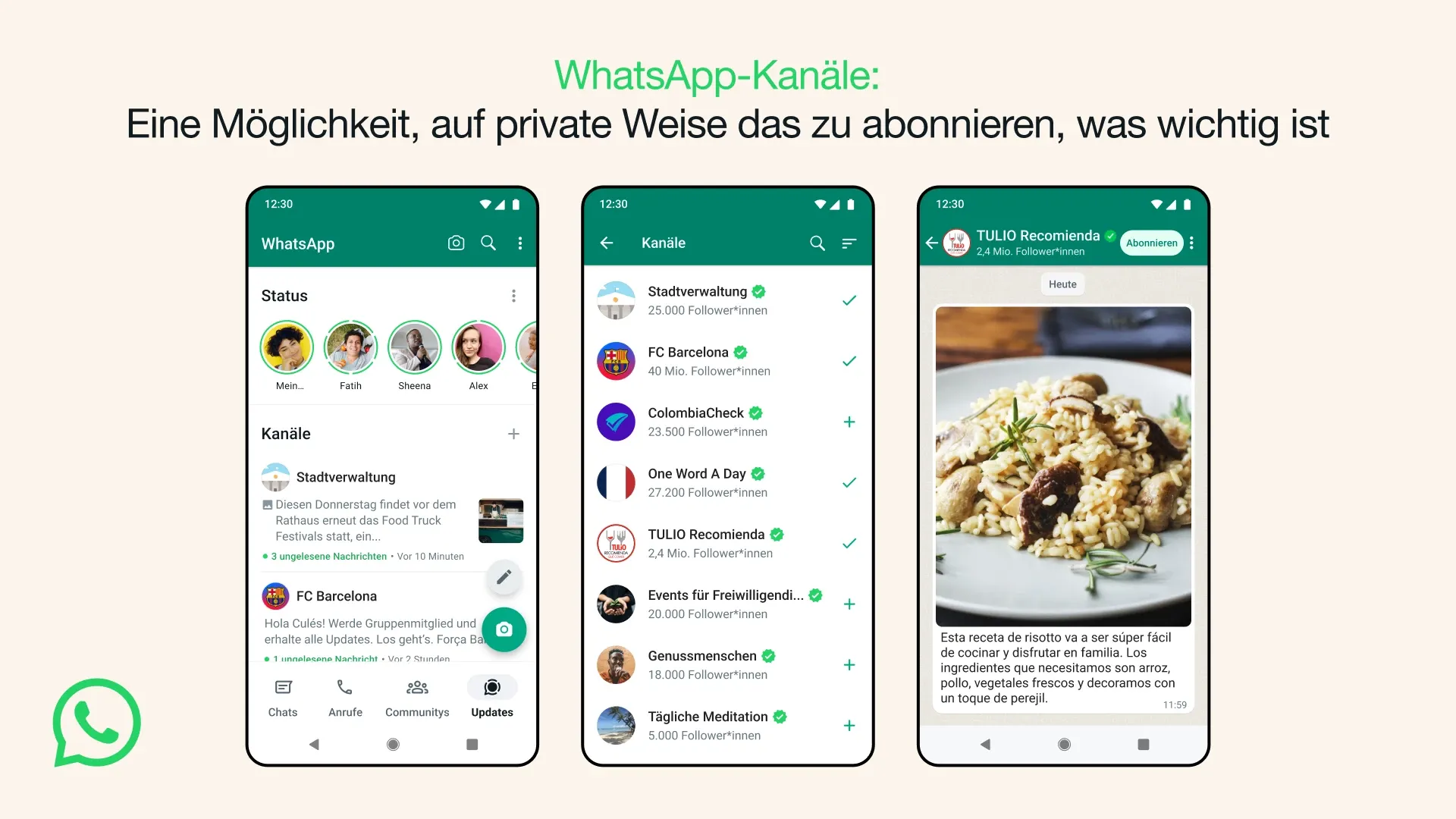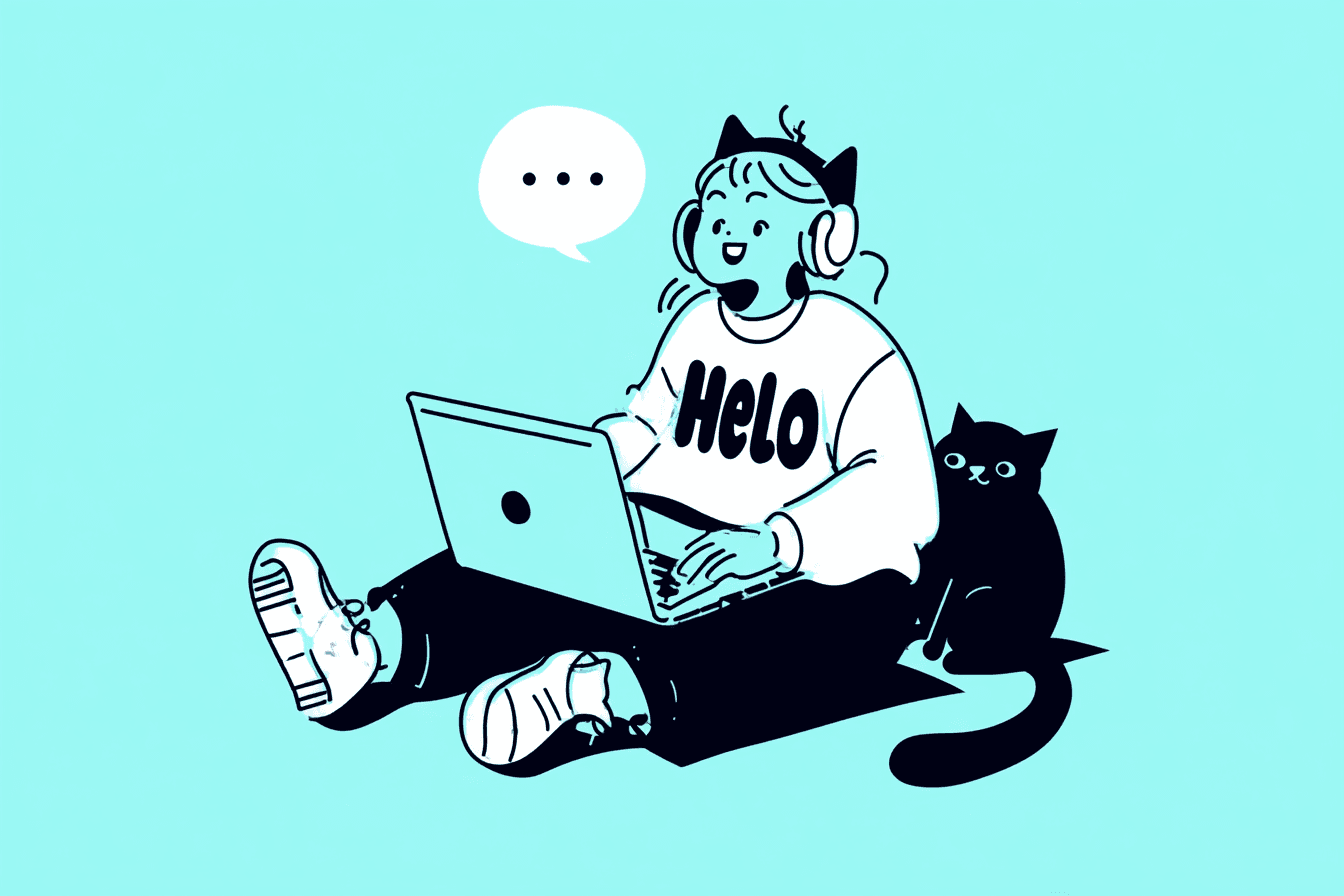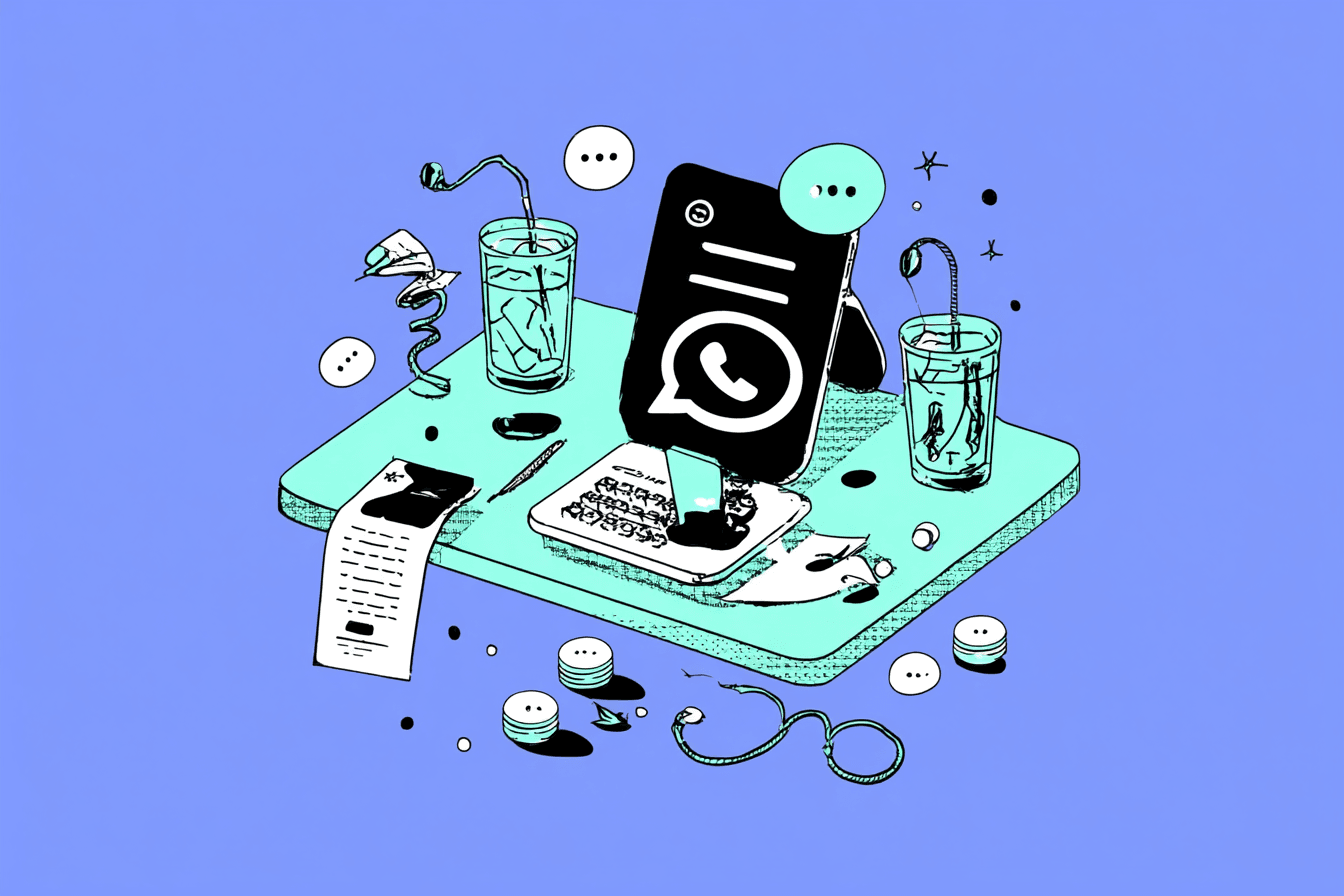What are WhatsApp Channels?
On September 13, 2023, META globally rolled out “WhatsApp Channels” for users. The WhatsApp Channels feature was tested in Colombia and Singapore before its launch. WhatsApp Channels are available in 150 countries globally, including Germany, Austria, and Switzerland. This "one-to-many" feature is reminiscent of platforms like Telegram groups or Instagram broadcasts and offers companies a great way to send messages to many (potential) customers simultaneously.
The goal is for you to follow your favorite companies, organizations, or clubs in a “timeline” reminiscent of the “Instagram home screen,” transforming WhatsApp from a messenger to a social media platform. Within a WhatsApp channel, followers can interact with messages by leaving emoji reactions, allowing you to better understand the interests of the people in your chat and respond to relevant topics. Large brands from various sectors now use WhatsApp Channels to share updates about the company and their brand or present offers for products and services. Another advantage for companies is that, unlike communication via the WhatsApp Business API, they do not have to pay for the messages.
Creating a WhatsApp Channel
WhatsApp Channels are an accessible feature available to almost anyone who meets the basic requirements. Here are the main prerequisites and target groups in detail.
Who Can Create a Channel
- Companies: Companies can use WhatsApp Channels to inform customers about new products, offers, and events, thereby increasing their reach and customer loyalty.
- Organizations: Clubs, NGOs, and other non-profit organizations can use channels to continuously provide members and interested parties with important updates and information.
- Individuals: Influencers, experts, and other individuals can create WhatsApp Channels to efficiently disseminate their content and messages to a wide audience, thus strengthening their presence and influence.
Requirements for a WhatsApp Channel
- WhatsApp Account: An existing WhatsApp account is the basic requirement for creating a channel.
- Updated App Version: Ensure that your WhatsApp app is up to date to access the channel feature.
- Topic Choice: A clearly defined topic or purpose helps to specifically address subscribers and share relevant content.

Source: WhatsApp
Creating a WhatsApp Channel: Step-by-Step Guide
Here is your step-by-step guide to creating your WhatsApp channel:
- Open your WhatsApp app and access Channels by clicking on the "Channels icon."
- Click on + Create Channel.
- Click Next and follow the on-screen instructions.
- Name your channel. This channel name can be changed at any time.
- Personalize your channel: Add a description and/or an image. These details can also be updated at any time.
- Click “Create Channel.” Voilà, you’re done!
At the launch in spring 2023, it was not entirely clear which companies would be able to create their own WhatsApp channel. By now, you can also create your WhatsApp channel in your WhatsApp Business or private app.

How to Join a WhatsApp Channel
Here’s how to join the WhatsApp channel of your favorite company or club:
- Make sure your WhatsApp app is up to date. Here are the links to the iOS and Android stores.
- Click on “Updates.”
- Where previously only the “Status” function was available, you will now also see “Channels.”
- Click “+” to find or subscribe to a WhatsApp channel.
- Scroll through your subscribed channels.
Unfortunately, you can only react with emojis on WhatsApp channels, which is the only analysis feature available to channel administrators. You cannot communicate or interact with other channel members. Automations and flows are not possible either. So WhatsApp channels remain a “one-to-many broadcast channel”. WhatsApp Channels is not end-to-end encrypted and therefore not GDPR-compliant. However, administrators do not have access to the WhatsApp usernames of channel members, nor do the members.
Pros and Cons of WhatsApp Channels
WhatsApp Channels are a new way to disseminate information to a broad audience. This feature offers companies and organizations numerous opportunities to increase their reach and efficiency. However, there are also some drawbacks to consider. Below are the key pros and cons of WhatsApp Channels.
Pros:
- Reach: Ability to reach a large number of subscribers simultaneously.
- Accessibility: Available in both the WhatsApp Business App and the regular WhatsApp App.
- Easy Setup: Channels can be easily created and personalized.
- Notifications: Real-time updates for all subscribers.
- Engagement: Direct reactions to posts through emojis.
Cons:
- Privacy: Chats are not end-to-end encrypted, hence not GDPR-compliant.
- Limited Interaction: Subscribers can only react with emojis to a message.
- No Dialogue: No direct communication between administrators and subscribers.
- Management: Requires regular updates and moderation.
Differences Between WhatsApp Channels and the WhatsApp Business Platform
Here's a brief overview of what you can do with WhatsApp Channels and what’s possible with the WhatsApp Business Platform:
| Feature | WhatsApp Channels | WhatsApp Business Platform |
|---|---|---|
| GDPR-compliant | ❌ | ✅ |
| Automations | ❌ | ✅ |
| Personalizations | ❌ | ✅ |
| One-to-many | ✅ | ❌ |
| One-to-one | ❌ | ✅ |
| API Integrations | ❌ | ✅ |
| Paid | ❌ | ✅ |
| Analytics & Reporting | ❌ | ✅ |
It is clear that the approach to “WhatsApp Channels” fundamentally differs from the direct marketing option of the “WhatsApp Business Platform,” which is based on the WhatsApp Business API that Chatarmin also uses. We see a cannibalization and competition to the extent that the “WhatsApp Newsletter” case is finally feasible. This was previously not scalable due to the WhatsApp Business Platform costs.
Use Cases Comparison: When “WhatsApp Channels” is Worth It
Use Cases Comparison: “one-to-many” vs. “one-to-one”:
| Use Case | one-to-many | one-to-one |
|---|---|---|
| Secret Access | ❌ | ✅ |
| Early Access | ❌ | ✅ |
| Private Drops | ❌ | ✅ |
| Lead Gen | ❌ | ✅ |
| Lead Enrichment | ❌ | ✅ |
| Lead Conversion | ❌ | ✅ |
| Information | ✅ | ✅ |
| News | ✅ | ✅ |
| Sales | ❌ | ✅ |
| Support & Service | ❌ | ✅ |
| Professional Analytics | ❌ | ✅ |
| Personalized Flows | ❌ | ✅ |
| API-triggered Flows | ❌ | ✅ |
| Community | ✅ | ❌ |
| B2B Sales | ❌ | ✅ |
With a fundamental understanding of marketing, one can see the pros and cons in both directions and accordingly handle WhatsApp Channels as well as the option to conduct scalable and GDPR-compliant direct marketing via WhatsApp Business Platform.
How to Evaluate a WhatsApp Channel?
Analyzing and monitoring the performance of WhatsApp Channels are essential aspects of measuring the success of this communication method. WhatsApp offers integrated statistics that help administrators better understand the interactions and reach of their channels. Here are some of the key statistical metrics:
- Number of Subscribers: Shows the number of people who have subscribed to the channel.
- Post Reach: Indicates how many subscribers have seen a post.
- Interactions: Measures the number of reactions (emojis) to posts.
- Post Frequency: Analyzes the regularity and frequency of shared content.
These statistics help administrators optimize their strategy and tailor content to subscribers' needs. Regular evaluation of this data allows companies and organizations to improve their communication measures and reach their target audience more effectively.
Outlook on WhatsApp Channels for 2025 & 2026 (Update 2026)
WhatsApp Channels are expected to evolve significantly by 2026, introducing new features that enhance engagement, security, and monetization opportunities.
Expanded Interaction Options: Beyond emoji reactions, WhatsApp might introduce features like comments, polls, and threaded replies. These additions would foster better engagement between administrators and subscribers, making channels more interactive and community-driven.
Advanced Analytics & AI Integration: WhatsApp is likely to enhance its analytics tools, providing administrators with deeper insights into engagement metrics, subscriber behavior, and content performance. AI-driven recommendations for content optimization could also become a key feature.
Monetization Features: To support businesses and creators, WhatsApp may roll out monetization options such as paid subscriptions, premium content access, and brand sponsorship opportunities. This would enable businesses to generate revenue directly from their audience.
Enhanced Security & Privacy Measures: With increasing concerns about data protection, WhatsApp is expected to introduce stronger security measures, such as encrypted analytics reports, improved moderation tools for admins, and advanced anti-spam features.
Cross-Platform Integration with Meta Services: Seamless integration with Meta's ecosystem (Facebook, Instagram, and Messenger) could allow content sharing, automated cross-platform updates, and unified channel management. This would enable businesses to maximize their reach across different platforms effortlessly.
These advancements will likely position WhatsApp Channels as a central tool for digital marketing and community engagement, offering businesses and creators innovative ways to connect with their audience in 2026.
Creating a WhatsApp Channel: A Conclusion
At Chatarmin, we find it unfortunate that “WhatsApp Channels” are not available for WhatsApp business accounts on the Business Platform. Thus, a company that wants to fully utilize WhatsApp's capabilities must:
- Sales & Support
- Channels
- Direct Marketing
use up to three WABAs (“WhatsApp Business Accounts”) with three different numbers. This ultimately leads to cannibalization and competition both in use cases and service providers. For the end user, it is simply confusing.
We welcome WhatsApp’s move towards more community and social media direction. This makes WhatsApp an even more integral part of our daily lives. A sensible WhatsApp marketing strategy will encompass both: a WhatsApp channel and a WhatsApp Business Platform channel for direct messaging in personalized 1:1 communication with end customers.
Frequently Asked Questions about "WhatsApp Channels"
What are WhatsApp Channels?
WhatsApp Channels are a feature that allows you to send information to many subscribers simultaneously. They work similarly to broadcast lists and are ideal for spreading updates and news without requiring direct responses.
What benefits do WhatsApp Channels offer businesses?
With WhatsApp Channels, you can reach a large audience and inform your customers about news and offers. It is an effective way to complement your marketing strategies and strengthen customer loyalty.
What content can I share on my WhatsApp Channel?
You can share text messages, images, videos, and links. The content should be relevant and interesting to your subscribers to keep their attention and promote engagement.
How do I increase the visibility of my WhatsApp Channel?
Promote your channel through social media, your website, and other communication channels. Regular and interesting posts help to capture subscribers' interest and gain new subscribers.
Can I manage multiple channels at the same time?
Yes, you can create and manage multiple channels simultaneously. This is especially useful if you want to target different audiences or topics.
How can I measure the performance of my WhatsApp Channel?
WhatsApp provides statistics such as the number of subscribers, post reach, and the number of reactions. This data helps you monitor the effectiveness of your channel and optimize your content.
Are there any limitations to using WhatsApp Channels?
Yes, interaction options are limited to emoji reactions, and there is no end-to-end encryption. These limitations should be considered when using and managing channels.
Are WhatsApp Channels suitable for small businesses?
Absolutely. WhatsApp Channels are easy to set up and manage, making them ideal for small businesses looking to efficiently and cost-effectively reach their customers.








